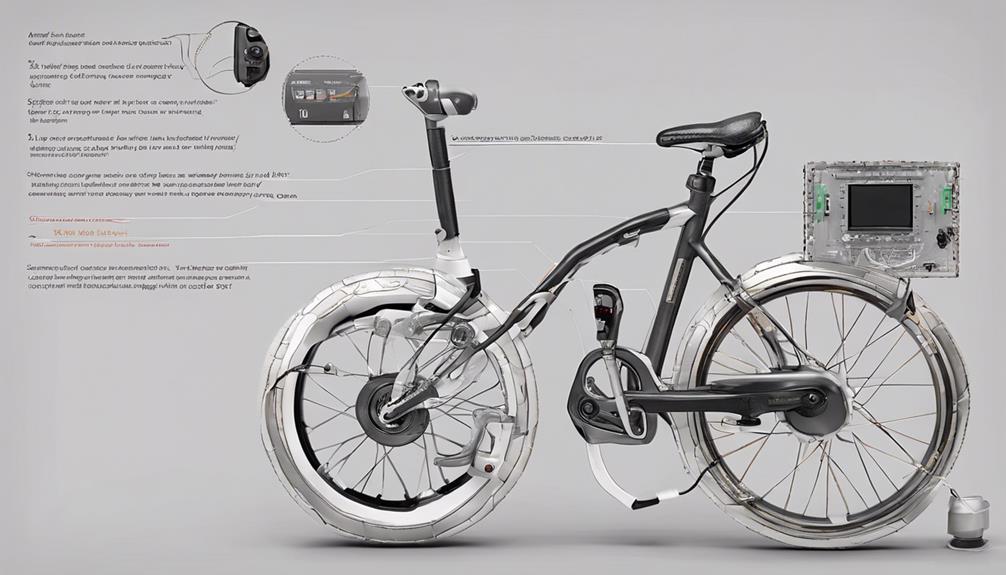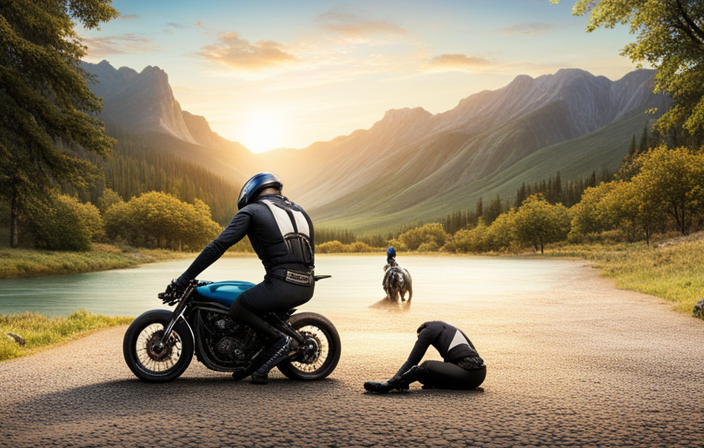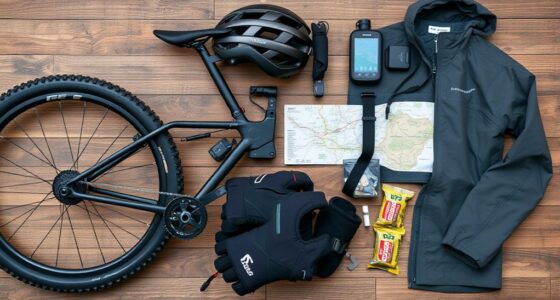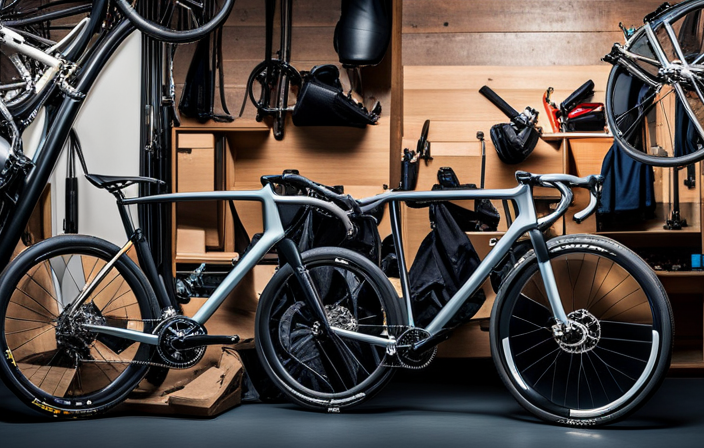Envision yourself at a fork in the road of exploration, caught in a dilemma between two choices: one route guides you to the challenging landscapes and thrill-packed paths of mountain biking, whereas the alternate path embarks you on an expedition across gravel roads and into unknown realms.
Both options offer thrilling escapades, but which bike should you choose?
In this article, we’ll explore the key differences between gravel bikes and mountain bikes, examining their design, features, and performance to help you make an informed decision.
So grab your helmet and let’s dive into the world of gravel bikes versus mountain bikes!
Key Takeaways
- Gravel bikes are designed for off-road adventures and combine the speed of road bikes with the durability and stability needed for off-road riding.
- Mountain bikes are built for tackling rugged and steep trails, with shorter wheelbases and steeper head tube angles for maneuverability, as well as suspension systems and wider handlebars.
- Gravel bikes have wider tires for better traction on loose surfaces, while mountain bikes have wider tires and advanced suspension technology for excellent traction on rough terrains.
- Gravel bikes are lighter and more efficient without suspension components, have a simplicity of design that reduces maintenance, and offer versatility in terms of tire options and adaptability to different terrains.
Types of Bikes: Gravel and Mountain
A gravel bike is designed for off-road adventures, while a mountain bike is specifically built for tackling rugged and steep trails. These two types of bikes have distinct characteristics that make them ideal for different terrains and riding styles.
When comparing a gravel bike to a road bike, the main difference lies in their versatility. A gravel bike combines the speed and efficiency of a road bike with the durability and stability needed for off-road riding. It features wider tires with more traction, allowing riders to tackle rougher surfaces like gravel roads or even dirt paths. On the other hand, a road bike is optimized for smooth pavements and high-speed riding.
Similarly, when comparing a mountain bike to a hybrid bike, we can see that mountain bikes are purpose-built machines for conquering challenging terrains. They are equipped with rugged frames, front suspension forks, and wide knobby tires to provide maximum control and stability on uneven trails. Hybrid bikes, on the other hand, offer a blend of road and mountain biking capabilities but lack some of the specialized features found in dedicated mountain bikes.
Understanding these key differences in design and frame geometry between gravel bikes vs mountain bikes will help you choose the right type of bicycle based on your desired terrain and riding preferences.
Moving forward into the next section about design and frame geometry…
Design and Frame Geometry
When it comes to gravel bike design and features, there are several key aspects to consider.
One important factor is the frame geometry, which is often designed to provide a balance between stability and agility. Gravel bikes typically have longer wheelbases and slacker head tube angles compared to road bikes, allowing for greater stability on rough terrain. Additionally, these bikes often feature wider tire clearances, allowing riders to tackle varied terrain with confidence.
On the other hand, mountain bike design and features cater specifically to off-road riding. The frame geometry of a mountain bike is typically more aggressive than that of a gravel bike, with shorter wheelbases and steeper head tube angles for increased maneuverability on tight trails. Mountain bikes also often feature suspension systems, either in the front (hardtail) or both front and rear (full suspension), which help absorb shocks from uneven terrain. Additionally, mountain bikes commonly have wider handlebars for improved control and knobby tires for enhanced traction on loose surfaces.
Overall, understanding the different design elements and features of gravel bikes and mountain bikes can help riders choose the right type of bike for their intended riding style and terrain preferences.
Gravel Bike Design and Features
To understand the design and features of a gravel bike, you need to know that it is built for endurance and versatility. Gravel bikes typically have wider tires compared to road bikes, ranging from 35mm to 45mm. These wider tires provide better traction on loose surfaces such as gravel or dirt roads.
Gravel bike frame materials are chosen for their durability and lightweight nature. Common materials include aluminum, carbon fiber, and steel. Aluminum frames offer a good balance between weight and affordability, while carbon fiber frames provide excellent stiffness and vibration damping properties. Steel frames are known for their strength and resilience against rough terrains.
With its specialized tire selection and frame materials, the design of a gravel bike allows riders to tackle long distances comfortably on mixed terrains.
Transitioning into mountain bike design and features, let’s explore how they differ in meeting specific off-road demands without compromising performance.
Mountain Bike Design and Features
If you’re looking for a bike that can handle rough terrains and off-road demands, it’s important to understand the design and features of a mountain bike. Mountain bikes are specifically designed to tackle challenging terrains with their robust construction and advanced suspension technology. The suspension system plays a crucial role in absorbing shocks and vibrations, providing a smooth ride even on bumpy trails. There are two main types of mountain bike suspensions: hardtail and full-suspension. Hardtail bikes have front suspension forks, while full-suspension bikes feature both front and rear suspensions. This allows for better control, traction, and comfort when riding over uneven surfaces.
In addition to the suspension technology, another important aspect of mountain bikes is tire options. These bikes typically come equipped with wide tires that provide excellent traction on various surfaces such as dirt, mud, rocks, or gravel. The tire size and tread pattern greatly influence the bike’s performance in different conditions. Larger tires offer more stability and better grip on rough terrain but may be slower on smoother surfaces. On the other hand, smaller tires provide quicker acceleration but may compromise stability on challenging trails.
Transitioning into the subsequent section about ‘tire size and tread pattern,’ it is essential to consider these factors when choosing the right bike for your needs."
Tire Size and Tread Pattern
The gravel bike’s tire size and tread pattern are different from those of a mountain bike. When it comes to tire pressure and puncture resistance, gravel bikes typically run at lower pressures compared to mountain bikes. This is because the wider tires used on gravel bikes allow for better shock absorption and increased traction on loose surfaces. Lower tire pressures also help in reducing the risk of punctures when riding over rough terrains.
In terms of tire width, gravel bikes usually have wider tires compared to mountain bikes. The wider tires provide a larger contact patch with the ground, offering more stability and grip on uneven surfaces. However, this increase in tire width also results in higher rolling resistance when compared to narrower mountain bike tires.
The tread pattern on gravel bike tires is designed to provide a balance between off-road performance and smooth rolling characteristics on paved roads. They often feature smaller knobs or a file-like tread pattern that allows for efficient pedaling while still delivering sufficient grip on loose surfaces.
Transitioning into the next section about suspension, it is important to note that unlike mountain bikes, gravel bikes do not typically come equipped with suspension systems. Instead, they rely on larger volume tires and frame compliance to absorb vibrations and shocks encountered during off-road rides.
Suspension
Unlike mountain bikes, gravel bikes typically do not have suspension systems and instead rely on larger volume tires and frame compliance for shock absorption. This design choice is influenced by the intended use of each bike.
Mountain bikes are built to handle rough terrains with obstacles like rocks, roots, and drops, requiring suspension to absorb impacts and maintain traction. On the other hand, gravel bikes are designed for long-distance rides on mixed surfaces such as pavement, gravel roads, and hard-packed dirt. While they may encounter some bumps along the way, these are usually less intense compared to mountain biking trails.
The absence of suspension in gravel bikes offers several advantages:
- Efficiency: Without suspension components weighing down the bike, it becomes lighter and more efficient during pedaling.
- Simplicity: Fewer moving parts mean less maintenance and fewer potential points of failure.
- Versatility: The lack of suspension allows for a wider range of tire sizes and tread patterns to be used interchangeably based on riding conditions.
With their focus on comfort over technical terrain features, gravel bikes prioritize stability and control through tire choice rather than relying on dedicated suspension systems. This enables riders to smoothly transition from pavement to rougher sections without sacrificing speed or performance.
Moving into the subsequent section about ‘gearing and drivetrain,’ it is important to consider how these components contribute to the overall ride experience of both mountain bikes and gravel bikes.
Gearing and Drivetrain
When it comes to gravel bike gearing and drivetrain, there are a few key points to consider. Firstly, gravel bikes typically have a wider range of gears compared to mountain bikes, allowing for easier climbing on rough terrain. Additionally, they often feature compact cranksets and wide-range cassettes for better versatility.
On the other hand, mountain bike gearing and drivetrain systems are specifically designed for off-road riding. They usually have a wider gear range than gravel bikes, with larger chainrings and cassettes that provide more options for tackling steep climbs or descents. Moreover, mountain bikes commonly incorporate features like clutch derailleurs to prevent chain drops during aggressive riding.
Understanding these differences in gearing and drivetrain between gravel bikes and mountain bikes can help riders choose the most suitable option based on their preferred terrain and riding style.
Gravel Bike Gearing and Drivetrain
For gravel bike gearing and drivetrain, you’ll want to focus on a wide range of gears for tackling various terrains. Gravel bikes are designed to handle both smooth roads and rough off-road trails, so having the right gearing is crucial for efficiency and performance.
The drivetrain efficiency of a gravel bike is typically optimized for endurance rather than high-speed racing. This means that the gear ratios are spaced closer together, allowing for smoother transitions between gears and better control over pedaling cadence.
Compared to mountain bikes, gravel bikes often have slightly higher gears on the top end, which allows for faster speeds on pavement or hard-packed dirt. However, they may not have as low of a gear range as mountain bikes, making steep climbs more challenging.
Moving on to mountain bike gearing and drivetrain…
Mountain Bike Gearing and Drivetrain
Now let’s shift our focus to the gearing and drivetrain of a mountain bike.
The gearing system on a mountain bike is designed to provide optimal pedal efficiency in various off-road terrains. Mountain bikes typically have a wide range of gear ratios, allowing riders to easily tackle steep climbs and descend rapidly.
The drivetrain usually consists of a combination of front chainrings and rear cassette gears, providing ample options for adjusting the intensity of pedaling based on the terrain. Additionally, mountain bikes often feature advanced technologies such as clutch derailleurs that reduce chain slap and improve stability over rough trails.
To paint a picture for you, imagine riding through rocky trails with your mountain bike:
- Engaging low gears to power up steep inclines.
- Swiftly switching into higher gears for smooth descents.
- Enjoying seamless shifting thanks to the clutch derailleur.
As we move forward, let’s delve into the next section about brake systems without skipping a beat.
Brake Systems
When it comes to brake systems, gravel bikes and mountain bikes have some key differences.
Gravel bike brake systems typically use mechanical disc brakes or hydraulic disc brakes with smaller rotors, providing ample stopping power on mixed terrain.
On the other hand, mountain bike brake systems often utilize larger rotors for enhanced heat dissipation and more aggressive stopping power needed in rugged off-road conditions.
Understanding these distinctions is crucial for choosing the right bike based on your intended riding style and terrain.
Gravel Bike Brake Systems
Gravel bikes typically use disc brake systems, while mountain bikes can have either disc or rim brakes. When it comes to gravel bike brake modulation, there are a few key features that set them apart from mountain bike brakes.
-
Hydraulic Disc Brakes: Gravel bikes often come equipped with hydraulic disc brakes, which provide better modulation and control compared to mechanical disc brakes.
-
Multiple Piston Calipers: Some gravel bike brake systems feature multiple piston calipers that distribute the braking force evenly across the rotor surface, resulting in improved stopping power and more consistent performance.
-
Larger Rotor Sizes: Gravel bike brake systems commonly use larger rotor sizes than their mountain bike counterparts. This larger rotor size enhances heat dissipation and improves overall braking performance during long descents or when riding on rough terrain.
Transitioning into the subsequent section about mountain bike brake systems, it’s important to understand how these differences affect the overall braking experience and power of a mountain bike.
Mountain Bike Brake Systems
Mountain bike brake systems can vary between disc and rim brakes. Disc brakes are becoming more popular due to their superior stopping power and performance in wet conditions. They consist of a metal rotor attached to the wheel hub, which is clamped by hydraulic or mechanical calipers to create friction and slow down the bike. On the other hand, rim brakes use pads that grip onto the sides of the wheel rims when engaged by levers. While they are less expensive and lighter than disc brakes, they are not as effective in wet conditions and require regular maintenance to prevent wear on the rims. Mountain bike riders should regularly check their brake pads for wear and replace them when necessary, while gravel bikers might consider upgrading their braking system for better performance on diverse terrains. Now let’s explore how riding terrain and style impact these bikes’ design choices.
Riding Terrain and Style
When it comes to terrain and riding style, gravel bikes and mountain bikes have distinct differences.
Gravel bikes are designed for a variety of terrains, ranging from smooth roads to rough gravel paths. They excel in providing stability and control on unpredictable surfaces, making them ideal for mixed-terrain adventures.
On the other hand, mountain bikes are specifically built to tackle off-road trails with rugged terrain, steep climbs, and fast descents. Their suspension systems offer maximum traction and absorption of bumps, allowing riders to navigate challenging obstacles with ease.
Gravel Bike Terrain and Riding Style
Explore various terrains and adapt your riding style on a gravel bike, as it offers versatility for different types of surfaces. When riding a gravel bike, you will experience the following:
-
Smooth Surfaces: Feel the freedom of gliding effortlessly on well-maintained roads or paved trails. The gravel bike’s narrower tires and lighter frame allow for increased speed and efficiency.
-
Gravel Paths: Conquer loose gravel with ease as the wider tires provide stability and better traction. The robust frame ensures durability even on rougher terrain.
-
Unpaved Roads: Navigate through dirt, mud, or grassy paths confidently with the off-road capabilities of a gravel bike. Its wider tire clearance allows for increased grip and control.
Gravel bikes are designed to handle these diverse terrains, making them an excellent choice for riders who enjoy exploring various surfaces.
Now let’s delve into mountain bike terrain and riding style to understand their contrasting features without skipping a beat.
Mountain Bike Terrain and Riding Style
Get ready to tackle rugged terrains and adapt your riding style on a mountain bike, as it offers an exhilarating experience with its robust frame and wider tires. Mountain bikes are designed to handle diverse off-road conditions, including steep climbs, rocky descents, and technical trails. One key element that sets mountain bikes apart is their suspension system. This feature helps absorb impacts from uneven surfaces, providing better control and comfort during the ride. Additionally, mountain bikes often have larger tire sizes compared to gravel bikes. The wider tires provide increased traction and stability on rough terrain. To illustrate the differences between gravel bike tire sizes and mountain bike suspension systems more clearly, refer to the table below:
| Gravel Bike Tire Size | Mountain Bike Suspension |
|---|---|
| 30-40mm | Front Suspension Only |
| Full Suspension |
The versatility and adaptability of mountain bikes make them ideal for exploring challenging trails with confidence.
Next section: ‘Versatility and Adaptability’
Versatility and Adaptability
You can easily switch between different terrains with a gravel bike or mountain bike. These bikes offer great adaptability in various terrains and versatility in riding styles. Here are five key features that highlight their capability:
-
Tire Selection: Both gravel bikes and mountain bikes have a wide range of tire options to choose from, allowing you to customize your ride for specific terrain conditions. From knobby tires for muddy trails to slicker tires for smoother roads, you can easily swap them out as needed.
-
Frame Design: Gravel bikes and mountain bikes are designed with specific frame geometries that optimize performance in different terrains. Gravel bikes often have more relaxed geometry, making them comfortable on long rides, while mountain bikes have steeper angles for better control on technical descents.
-
Suspension Systems: Mountain bikes typically come equipped with front or full suspension systems to absorb impacts on rough trails, providing a smoother ride. Gravel bikes usually have rigid frames but may offer the option of adding front suspension forks for added comfort.
-
Braking Systems: Both types of bicycles feature powerful braking systems, but mountain bikes often employ hydraulic disc brakes that deliver precise stopping power even in wet or muddy conditions. Gravel bikes commonly use mechanical disc brakes which provide reliable braking performance across various terrains.
-
Gearing Options: Gravel and mountain bikes offer a wide range of gear ratios to tackle different gradients and speeds encountered on diverse terrains. This allows riders to maintain an optimal cadence regardless of the riding style or terrain they encounter.
With their adaptability in varied terrains and versatility in riding styles, both gravel bikes and mountain bikes excel at conquering challenging landscapes with ease. Transitioning into the subsequent section about ‘speed and efficiency,’ it’s important to understand how these bicycles maximize performance without compromising their versatile nature.
Speed and Efficiency
Transitioning into the subsequent section about speed and efficiency, it’s crucial to understand how these bicycles optimize performance while maintaining their versatile nature.
When it comes to speed, gravel bikes and mountain bikes have some key differences. Gravel bikes are designed to provide a balance between speed and endurance. They feature a more aerodynamic frame geometry compared to mountain bikes, allowing for greater efficiency on paved roads. Additionally, gravel bikes often come equipped with narrower tires that reduce rolling resistance and enhance speed.
On the other hand, mountain bikes prioritize stability over pure speed. Their geometry is optimized for off-road terrain, featuring a more upright riding position that enhances control and maneuverability in technical sections. Mountain bike tires tend to be wider than those of gravel bikes, providing better traction on loose surfaces like dirt or mud.
When comparing gravel bikes to road bikes, the latter are generally faster due to their lightweight frames and narrow tires built specifically for high-speed pavement riding. Road bikes excel in delivering maximum efficiency on smooth surfaces but may lack the versatility needed for off-road adventures.
In conclusion, understanding the trade-offs between speed and endurance is essential when considering whether a gravel bike or mountain bike suits your needs best.
Transitioning into the subsequent section about comfort and stability allows us to delve deeper into these aspects without compromising overall performance.
Comfort and Stability
When it comes to gravel bike comfort and stability, one of the key factors is the geometry of the bike. Gravel bikes are designed with a more relaxed geometry compared to mountain bikes, which allows for a more comfortable riding position over longer distances. This design also provides better stability on uneven terrain.
On the other hand, when discussing mountain bike comfort and stability, suspension plays a crucial role. Mountain bikes are equipped with front and rear suspension systems that absorb shocks and vibrations from rough trails, providing a smoother ride. This added suspension not only enhances comfort but also improves stability by keeping the tires in contact with the ground.
Overall, both gravel bikes and mountain bikes prioritize comfort and stability in their design, but they achieve it through different means. While gravel bikes focus on geometry for a comfortable riding position and stable handling, mountain bikes rely on suspension systems to absorb impacts and maintain traction on challenging terrains.
Gravel Bike Comfort and Stability
Gravel bikes offer a more comfortable and stable ride compared to mountain bikes. This is due to the unique design features found in gravel bike handlebars and the absence of complex suspension technology found in mountain bikes. Gravel bike handlebars, commonly known as drop bars, provide multiple hand positions, allowing for better ergonomics and reduced fatigue on long rides. The wider tire clearance and lower tire pressure options also contribute to a smoother ride over rough terrain. Additionally, gravel bikes often feature a more relaxed geometry, providing a more upright riding position that enhances stability and control.
To evoke emotion in the audience, consider the following table:
| Feature | Gravel Bike | Mountain Bike |
|---|---|---|
| Handlebars | Drop Bars | Flat Bars |
| Suspension | Minimal or None | Full Suspension |
| Riding Position | Upright | Forward-leaning |
With these factors combined, gravel bikes are optimized for comfort and stability on varied surfaces. Transitioning into the subsequent section about mountain bike comfort and stability without using ‘step’, it is important to understand how these differences impact the overall riding experience.
Mountain Bike Comfort and Stability
In contrast, mountain bikes prioritize a forward-leaning riding position and full suspension technology for improved comfort and stability on rugged trails.
Mountain bike suspension systems are designed to absorb impact and provide a smooth ride over rough terrain. They typically consist of front forks with travel ranging from 100mm to 200mm, and rear shocks that allow the bike to handle jumps, drops, and bumps without transferring excessive force to the rider. This suspension setup reduces fatigue and enhances control by keeping the wheels in contact with the ground.
Additionally, mountain bikes often have wider tires than gravel bikes, typically ranging from 2.2 inches to 2.6 inches in width. The larger tire size improves traction and stability on uneven surfaces such as rocks or roots.
Transitioning into the subsequent section about ‘weight and portability’, these features contribute to a slightly heavier build compared to gravel bikes but provide superior performance off-road.
Weight and Portability
The weight and portability of a gravel bike is typically more favorable compared to a mountain bike. When it comes to weight, gravel bikes are designed to be lightweight without compromising durability. This allows riders to easily maneuver through various terrains, making them ideal for long-distance rides or multi-day adventures. In contrast, mountain bikes tend to be heavier due to their sturdier construction and components that are built for off-road trails and extreme conditions.
In terms of portability, gravel bikes have an advantage over mountain bikes as well. Some models even come with folding capabilities, which make transportation and storage much easier. Imagine being able to fold your bike neatly into the trunk of your car or store it in a small apartment effortlessly!
To further illustrate the difference in weight and portability between these two types of bikes, consider the following table:
| Criteria | Gravel Bike | Mountain Bike |
|---|---|---|
| Weight | Lighter | Heavier |
| Portability | Foldable options | Less portable |
Now let’s delve into the next section about price range and affordability without missing a beat.
Price Range and Affordability
Looking for a new ride? Let’s talk about the price range and affordability of these two options.
When comparing gravel bikes and mountain bikes, it’s important to consider your budget and what you’re willing to spend. Gravel bikes tend to be more affordable compared to mountain bikes, making them a great choice for riders on a budget. You can find gravel bikes that range from around $500 to $2000, depending on the brand and components. These budget-friendly options still offer excellent performance and durability.
On the other hand, mountain bikes can vary significantly in price. Entry-level mountain bikes typically start at around $500, but high-end models can cost well over $10,000. The price difference is largely due to the specialized components required for off-road riding and the advanced technology used in manufacturing these bikes.
When considering affordability comparison between gravel bikes and mountain bikes, it’s important to note that while gravel bikes may be more budget-friendly overall, there are still options available at different price points within both categories.
Now that we’ve discussed the price range and affordability of these two bike types, let’s dive into popular brands and models without skipping a beat.
Popular Brands and Models
Let’s now explore some popular brands and models in the world of gravel bikes and mountain bikes.
When it comes to gravel bikes, there are a few brands that stand out among enthusiasts. Specialized offers their Diverge model, which is known for its versatility and smooth ride on various terrains. Another popular brand is Trek with their Checkpoint series, designed to handle long rides and rough surfaces with ease. Canyon also deserves mention with their Grail lineup, featuring innovative designs for enhanced comfort and control. And finally, Giant’s Revolt series is highly regarded for its durability and reliability.
On the other hand, when it comes to top mountain bike models, companies like Santa Cruz have gained a loyal following with their high-performance options such as the Bronson or Nomad. Yeti Cycles is another respected brand offering exceptional mountain bikes like the SB150 or SB130 that deliver excellent suspension performance and handling capabilities. Additionally, Pivot Cycles’ Mach 6 model has received praise from riders for its ability to tackle challenging trails effortlessly.
Now that we’ve explored some popular brands and models in both categories, let’s move on to choosing the right bike for your needs without compromising performance or comfort.
Choosing the Right Bike for Your Needs
When choosing the right bike for your needs, it is crucial to consider your preferred terrain and riding style. These factors will determine whether a gravel bike or a mountain bike is more suitable for you.
One important aspect to consider is the size of the bike. Ensure that you choose a size that fits you properly, as this will greatly impact your comfort and performance on the bike.
Additionally, budget considerations play a significant role in selecting the right bike. Determine how much you are willing to spend and look for options within that range.
In terms of terrain, if you primarily ride on smooth roads or gravel paths, a gravel bike would be an excellent choice. It offers versatility with its wider tires and relaxed geometry, providing stability and comfort on uneven surfaces.
On the other hand, if you enjoy tackling rough trails or steep climbs, a mountain bike would be more suitable. Its suspension system and knobby tires offer enhanced traction and control on challenging terrains.
Considering these factors will help you make an informed decision about which type of bike is right for you.
In conclusion, both gravel bikes and mountain bikes have their own unique advantages depending on your preferences and riding style.
Conclusion: Gravel Bike vs Mountain Bike – Which One is Right for You?
To determine which one is right for you, consider your preferred terrain and riding style. When comparing a gravel bike vs mountain bike, it’s important to understand their key differences.
A gravel bike is designed for long rides on mixed terrain, combining elements of both road and cyclocross bikes. It features a more relaxed geometry, wider tires with tread patterns suitable for off-road conditions, and often includes mounting points for racks and fenders.
On the other hand, a mountain bike is specifically built for off-road trails and rough terrains. It has a more aggressive geometry with suspension forks and wide knobby tires to handle technical obstacles.
If your main focus is exploring unpaved roads or tackling gravel adventures while still enjoying some paved sections, a gravel bike would be the ideal choice. It offers versatility and comfort on various surfaces without compromising speed on smooth roads.
However, if your primary goal is conquering challenging trails with steep descents and technical climbs, then a mountain bike would suit you better.
Ultimately, the decision between a gravel bike vs mountain bike comes down to your personal preferences and intended use. Consider the type of riding you enjoy most and choose accordingly – whether it’s conquering dirt paths or shredding through rugged singletrack trails.
Frequently Asked Questions
Can I use a gravel bike for mountain biking?
Yes, you can use a gravel bike for mountain biking, but there are limitations. Gravel bikes are designed for mixed terrain and long-distance riding. They are not built specifically for off-road trails like mountain bikes, which have features like suspension systems and wider tires. While a gravel bike can handle less technical trails, it may struggle with more challenging terrain due to its limited suspension and narrower tires.
So, while it is possible to use a gravel bike for mountain biking, it is not ideal for intense mountain biking experiences.
What are the advantages of a mountain bike over a gravel bike?
The advantages of a mountain bike over a gravel bike are numerous. Firstly, mountain bikes have more robust frames and suspension systems, allowing them to handle rough terrains with ease.
Additionally, they typically have wider and knobbier tires that provide better traction on uneven surfaces.
Mountain bikes also come equipped with a wider range of gears, enabling riders to conquer steep climbs and descend at high speeds safely.
These features make mountain biking ideal for adventurous off-road enthusiasts seeking thrilling experiences.
Can I use a mountain bike for gravel riding?
Yes, a mountain bike can be used for gravel riding, but it has its limitations.
Mountain bikes are designed for off-road trails with rough terrain and obstacles. They have wide tires, front suspension, and a sturdy frame to handle these conditions.
However, compared to gravel bikes, mountain bikes tend to be heavier and have more aggressive geometry, which may affect speed and efficiency on smoother surfaces like gravel roads.
Gravel bikes offer benefits such as lighter weight, faster rolling tires, and a more comfortable riding position for longer distances on gravel surfaces.
Do gravel bikes have suspension?
Gravel bikes, unlike mountain bikes, do not typically come with suspension. This absence of suspension may seem daunting at first, but it has its benefits. Without suspension, gravel bikes are lighter and more efficient on smoother surfaces.
However, this lack of suspension means that they may not handle rough terrain as well as mountain bikes or cyclocross bikes. It’s important to consider your riding preferences and the type of terrain you’ll be encountering before deciding on a bike with or without suspension.
Is it possible to switch between tires for different terrains on a gravel bike?
Yes, it’s possible to switch tires for different terrains on a gravel bike. The key factor in tire compatibility is the width of the tire and the clearance provided by the bike frame.
Gravel bikes usually have ample clearance to accommodate various tire widths, allowing riders to easily swap between narrower tires for smooth surfaces and wider, more aggressive tread patterns for off-road adventures.
This versatility makes gravel bikes ideal for tackling a range of terrains with confidence.
Conclusion
After carefully comparing the features and benefits of gravel bikes and mountain bikes, it’s clear that both options have their own unique advantages.
The decision ultimately comes down to your specific needs and preferences. Whether you seek the thrill of off-road adventures or the versatility of all-terrain exploration, there is a bike out there for you.
So, gear up, embrace the suspense of choosing the perfect ride, and get ready to embark on unforgettable cycling experiences that will take you places you never imagined.
Happy riding!









